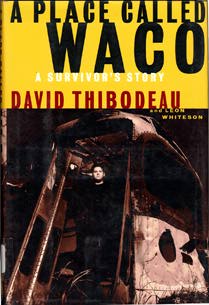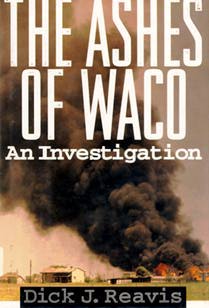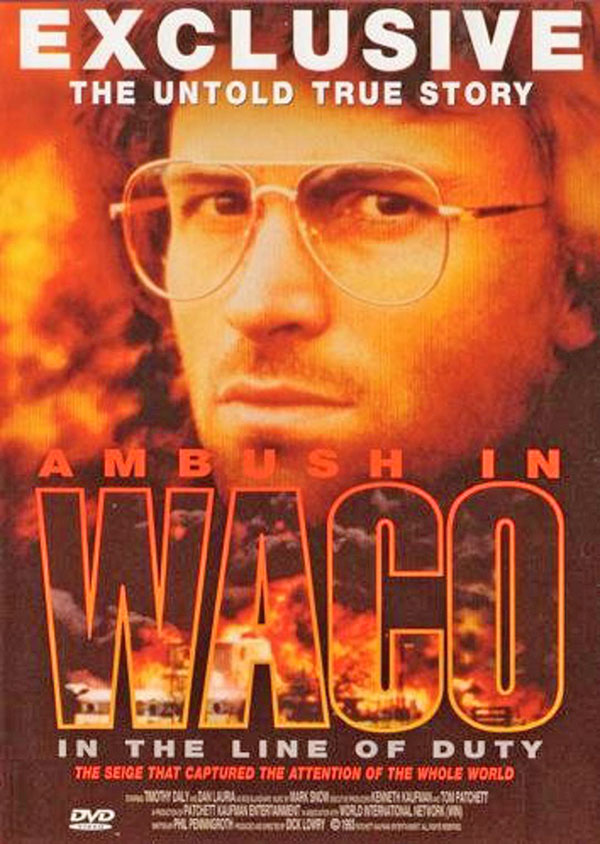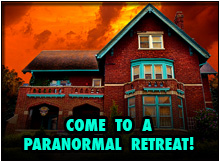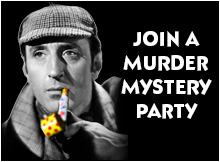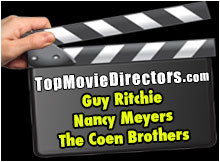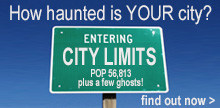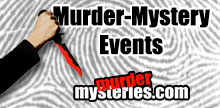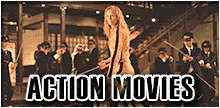The Disappearance of Jimmy Hoffa
— CoverUps.com
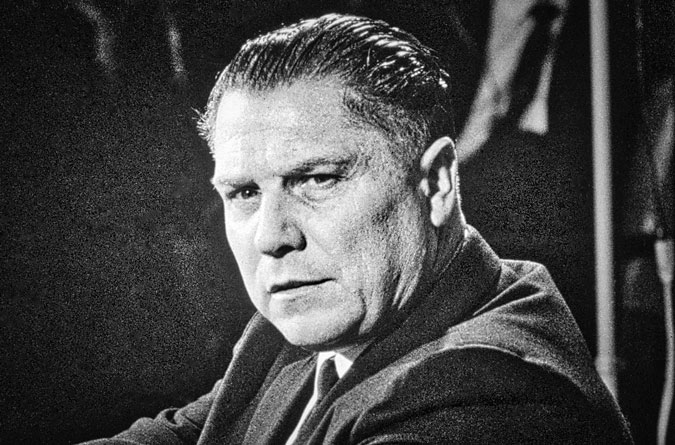
Jimmy Hoffa, president of the Teamster’s Union, disappeared without a trace on July 30, 1975. He led the teamsters from 1957 to 1971, and from the beginning had been instrumental in unionizing workers — he was the brains and guts behind its success.
It was alleged and widely known that Jimmy Hoffa had ties to organized crime. He admitted that liaisons with the Mob were needed, because the Mob had the power to disrupt strikes, so deals had to be made with them. Federal investigators pursued him in the 1950s and ‘60s without much success at first, but law enforcement efforts eventually bore fruit.
The Justice Department during the Kennedy Administration turned up the heat and convictions were finally made in 1964. In 1967, after all of Hoffa's appeals were exhausted, he was sent to federal prison at Lewisburg, PA., convicted on the testimony of a teamster, Edward Grady Putin, who was awaiting trial for a variety of crimes, and had made a deal with the prosecution. Thus Hoffa was convicted of pension fund fraud, jury tampering, and conspiracy, together with fellow Teamster Tony "Pro" Provenzano, whom Hoffa blamed for attracting federal interest in the first place to his illegal activities.
Hoffa only served four years of his 13 year sentence, after President Nixon commuted his sentence with the understanding that Hoffa would be legally barred from holding office in the Teamsters until 1980, which would’ve been the end of his original 13-year sentence anyway. The deal was made between the White House and Union Vice-President Frank Fitzsimmons, who emerged as Hoffa’s rival for power in the Union.
On July 30th, 1975 things began poorly for Hoffa, when New Jersey mob leaders Tony Giacalone and Tony Provenzano stood him up at the luncheon meeting they'd agreed to at the Machus Red Fox restaurant in Michigan. Hoffa's penchant for punctuality was well known, and the fact that he was left cooling his heels was a clear sign of disrespect in what had become a bitter struggle for power, for though Hoffa was ostensibly barred from holding a Teamster leadership position, his intention of returning to the summit of the organization he'd built could not have been clearer. Several hours passed, and Hoffa called home to see if anyone had left any messages. His last call was to his friend Louis Linteau. After that a car did finally pick him up, and he was last seen sitting in the back seat with several men, who in turn reportedly leaning forward to talk to the driver. The FBI think Hoffa never left that car alive. His blood and hair were found in it later.
When he failed to come back, authorities swung into a full man hunt, questioning Hoffa's Union Mob friends, digging up various places, hammering walls and cement floors in search of his body, but to no avail. The FBI theorize that his body was run through a Mob-controlled fat-rendering plant that was later mysteriously destroyed by fire. In 1983, Hoffa was declared legally dead.
Hoffa had many powerful and motivated enemies. At the top of the list were people like Russell Bufalino, Anthony "Tony Pro" Provenzano and three Hoffa cronies, Thomas Andretta, Gabriel Briguglio and Salvador Briguglio. There wasn’t enough evidence to charge any of them, but they all wound up in prison for other crimes.
In 2001, DNA tests by FBI experts tied Hoffa to his friend’s car, an associate by the name of Charles O'Brien.
Many observers theorize that he'd begun to "spill the beans" about the connections between the Union and organized crime; he was livid about the deal Fitzsimmons had cut with the White House.
Others think he was rubbed out because he was trying to regain his power in the Union, and certain individuals weren’t about to let him. Tony Provenzano had told him at one point, "get out of Union politics or else." The F.B.I. and many teamsters think that Provenzano personally ordered Hoffa’s death, and the new Jersey Mafia did the deed and disposed of the body. But Provenzano had an air-tight alibi.
Others have linked Hoffa's murder to various elements of the ongoing and corrupt ties between the mob and the Union, whose pension funds had been blended with illegal profits from gambling, prostitution and narcotics. Many speculate that the Mob found Hoffa’s replacement, Frank Fitzsimmons, was much easier to manipulate and cut deals with, as opposed to Hoffa, who was notoriously tough. Also, the Nixon Administration approved of Fitzsimmons, and would be more likely to relax law enforcement surveillance of the Teamsters, thus making life much less difficult for the Mob.
In his book "The Last Mafioso", however, Jimmy "The Weasel" Fratianno wrote that Hoffa wasn’t killed by the New Jersey Mob at all, but by the local Detroit Mafia bosses. He says that Tony Giacalone, a close friend of Hoffa set him up, and Tony Zerilli and Mike Polizi ordered him killed.
Others have claimed he wasn’t dead, just in hiding. One Teamster stuck to his story when diligently questioned by the authorities that Hoffa had run off to Brazil with a black go-go dancer.
Data Resources include: Mysteries of the Unexplained, The Reader’s Digest Association; detnews.com; thepetdetective.com; who2.com; and carpenoctem.tv.
PHOTOGRAPHS
Hover your mouse over the pictures below for captions.
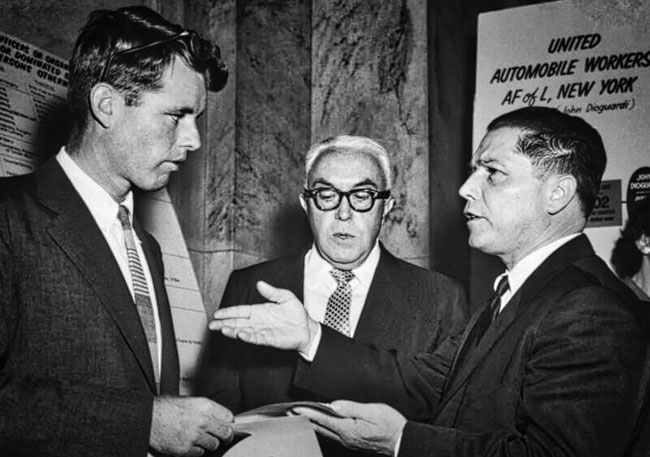
Robert F. Kennedy speaks with Hoffa in this photograph. At the time, Kennedy was chief counsel for the Senate McClellan Committee and was investigating Hoffa's ties to organized crime.

In May 1959, after the Senate McClellan Committee investigation of the Teamsters, Life Magazine put Hoffa on its cover and characterized the Teamsters as a "national threat" and wondered what they might do if allowed to continue unchecked.
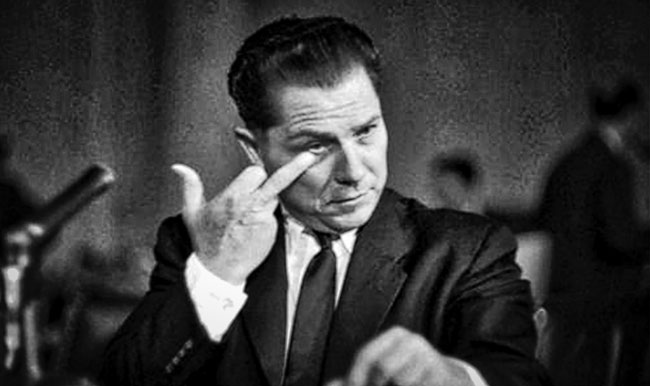
Hoffa flips off attorney Robert Kennedy during a Senate committee hearing in 1957.
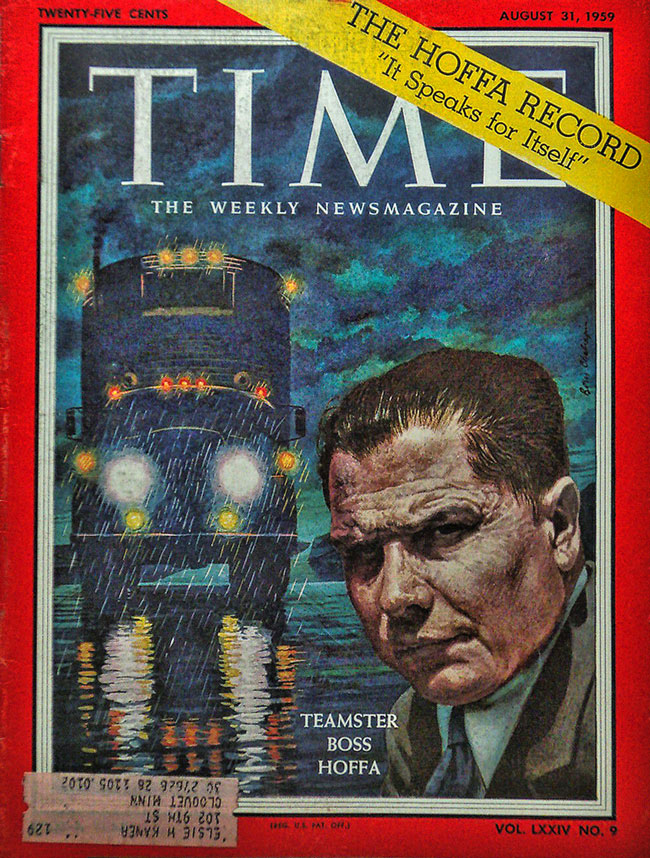
Senate committee investigations into the Teamsters played a large part in making Jimmy Hoffa widely feared to the point of being a household name in the late '50s.
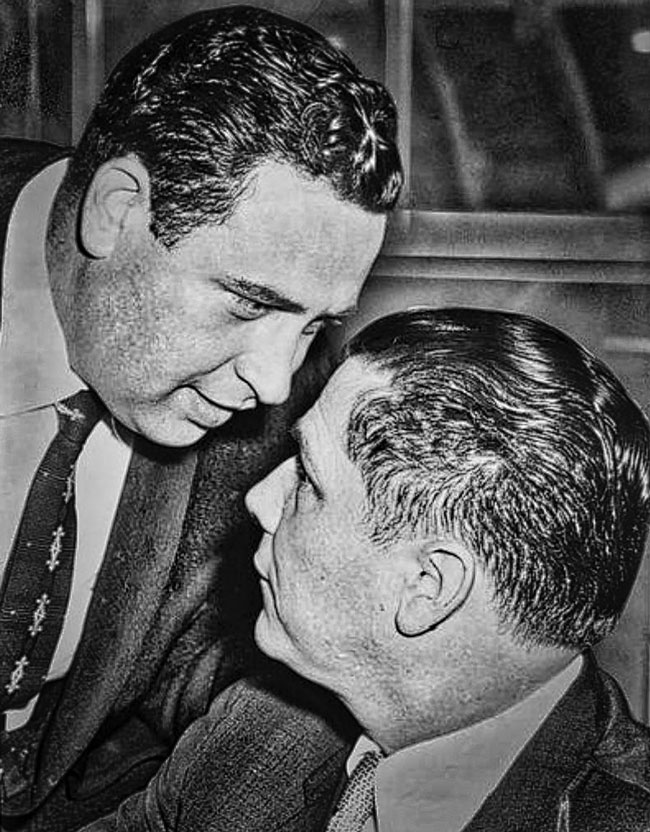
Bernard Spindel and Jimmy Hoffa after a 1957 court session in which they pled not guilty to illegal wiretap charges. Spindel was a surveillance, wiretapping, electronics and lock-picking expert. A 1966 article in Life magazine called him the "No. 1 big-league freelance eavesdropper and wiretapper in the U.S."

Hoffa leaves court after his jury tampering trial. He was found guilty on two counts and acquitted on a third.

Hoffa casts his reel into the water off the side of his boat "The Yellow Rose II" during a fishing trip with cohorts off the coast of Miami.
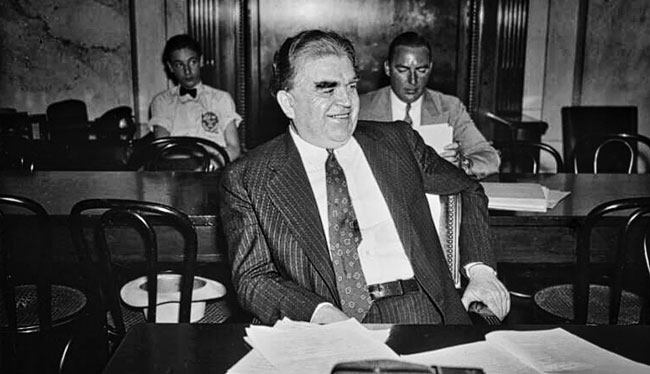
John L. Lewis, head of the Congress of Industrial Organizations (CIO), attempted to established a CIO-affiliated union for the transportation and warehousing industry to compete with Jimmy Hoffa's Teamsters. The conflict between the two unions often turned violent.

Like other Teamsters — as well as members of the United Auto Workers and other unions of the day — Hoffa fought hard in the most visceral and physical sense of the word. The muscular, five-foot-five organizer suffered dozens of injuries during his days on the front lines.

Hoffa was so popular with rank-and-file Teamsters that they re-elected him as president of the union in 1968 while he was still in prison. It wasn’t so much that supporters thought Hoffa was innocent — he was obviously guilty — but for the membership, everyone in power was just as guilty as Hoffa, if not more so.

Hoffa with his family in a photo taken in 1956. Left to right: son James, 15, daughter Barbara Ann, 18, and his wife, Josephine. He always maintained that family came before work, but his punishing schedule and long workdays were an unchanging fact of life for them.

Many years after this picture of Hoffa and his son was taken, the latter would lead the union through a different era.
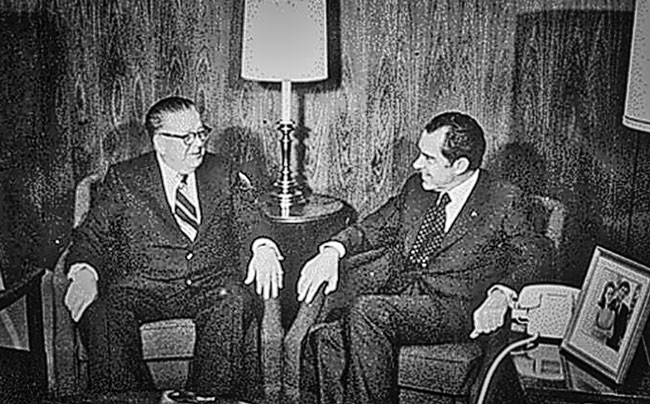
Teamsters acting president Frank Fitzsimmons is thought to have solicited a commutation of Jimmy Hoffa's prison sentence from president Nixon in 1971 – with the stipulation that Hoffa could not return to a leadership position in any union until 1980.

Police and family believe Hoffa's stepson Charles "Chuckie" O'Brien played a role in Hoffa's disappearance. O’Brien and Hoffa were fighting over Hoffa refusing to back O’Brien’s bid for a Teamsters’ administrative post at Local 299 at the time.
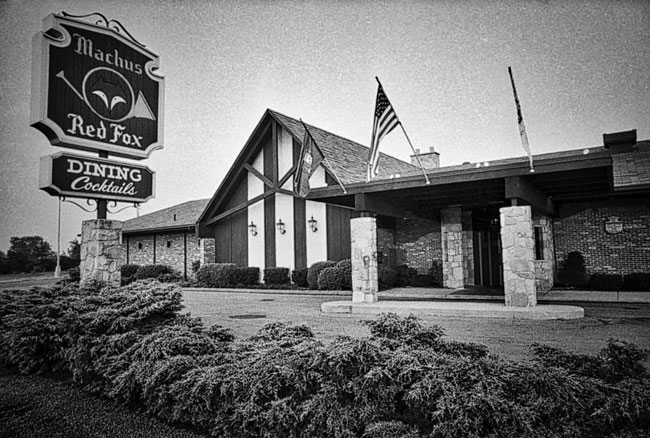
The Machus Red Fox restaurant in Bloomfield Township, Michigan, is shown here circa August 1975. Jimmy Hoffa was last seen standing outside the restaurant on July 30, 1975.

Anthony Giacalone, a member of the Detroit Partnership Mafia organization in a 1975 mugshot. Giacalone is one of the Detroit mobsters the FBI investigated in connection with Hoffa's disappearance.
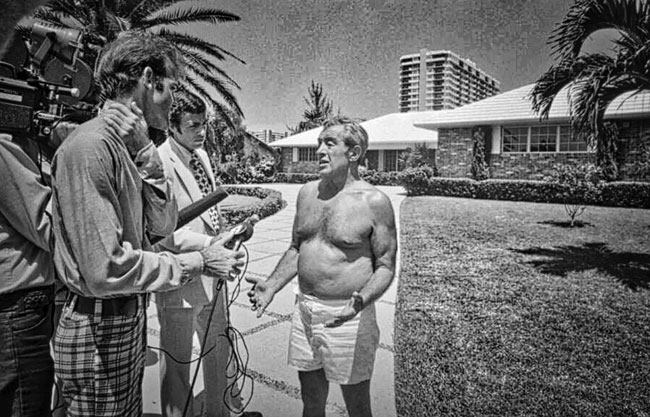
Anthony "Tony Pro" Provenzano talks with newsmen outside his home a week after Hoffa's disappearance in August, 1975. It is believed Hoffa was on his way to a luncheon with Provenzano when he disappeared.
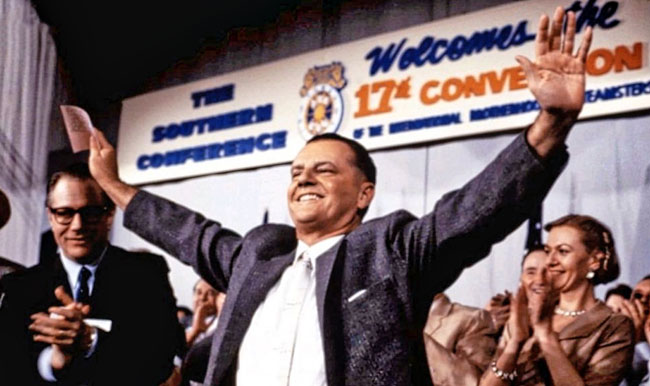
"Does the movie agree, then, that Jimmy Hoffa was a tool of organized crime? Not at all. It argues that Hoffa would take any help he could get, anywhere he could find it, to organize the drivers and put pressure on the owners. He was a union pragmatist."
– From Roger Ebert's review of Hoffa, starring Jack Nicholson
"Hoffa" Movie Review
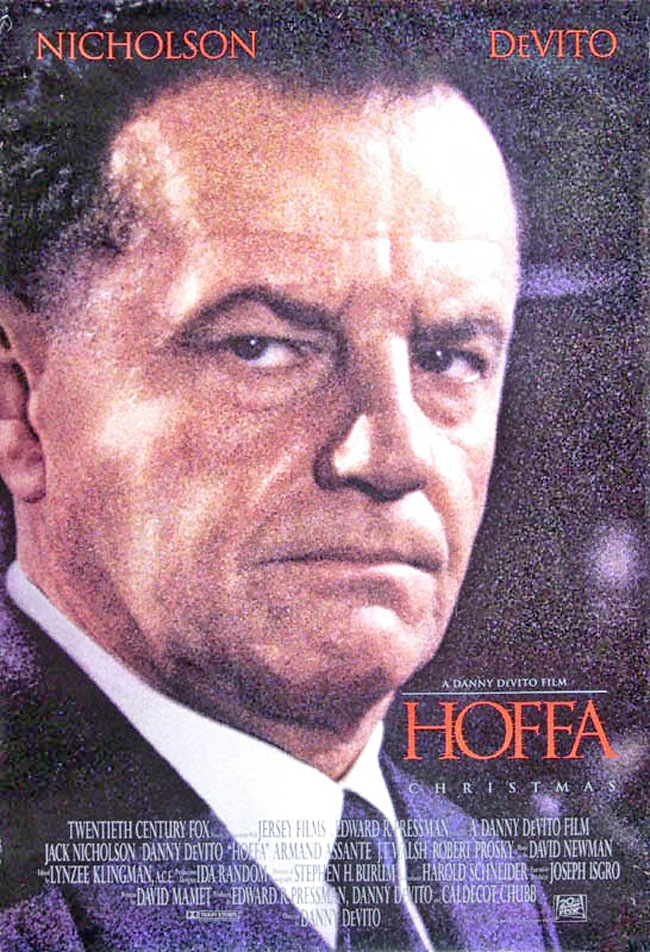
The 1992 biographical film "Hoffa" was a critical and box-office disappointment, but film critic Roger Ebert gave the film 3.5/4 stars and wrote:
"Here is a movie that finds the right look and tone for its material. Not many directors would have been confident enough to simply show us Jimmy Hoffa instead of telling us all about him. This is a movie that makes its points between the lines, in what is not said. It's not so much about what happened to Jimmy Hoffa, as about the fact that something eventually would."
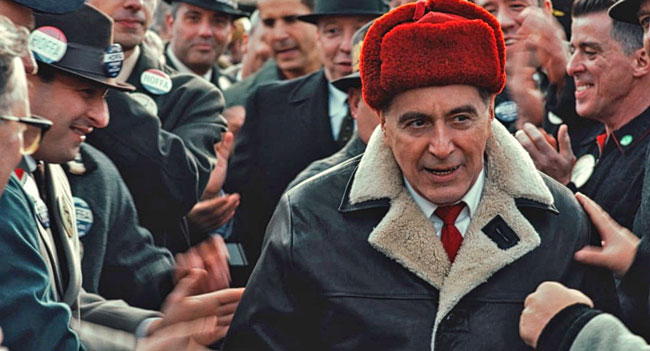
"As Jimmy Hoffa, Al Pacino is disarmingly funny and larger than life: delivering many of the film's soon-to-be iconic lines as he preaches punctuality ("I never waited for anyone who was late more than 10 minutes") and proper self-defense ("You charge with a gun – with a knife, you run")."
USA Today Review of
"The Irishman"
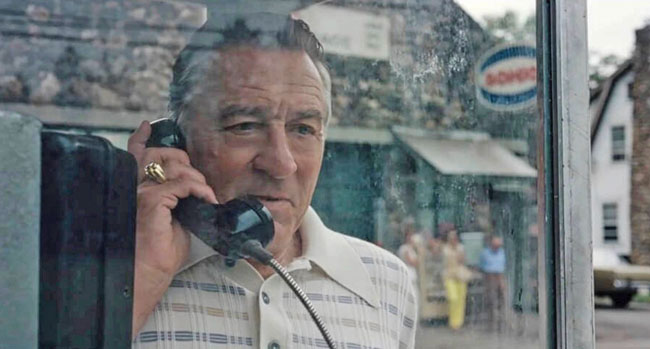
Frank Sheeran, played by Robert De Niro in The Irishman, claims to have been the one who killed Jimmy Hoffa, but there is reason to doubt his confession.
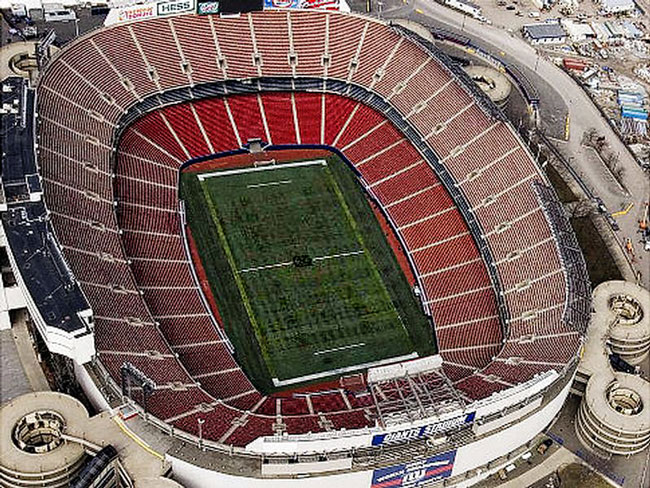
Jimmy Hoffa is said to have attended every event at Giants Stadium since 1976. According to hitman Donald "Tony The Greek" Frankos, Hoffa's body was cut up in Michigan, then driven to New Jersey several months later and buried in the concrete foundation of Giants Stadium when it was under construction. Frankos even claimed to know what area of the stadium: Section 107, in the corner of the west end zone.
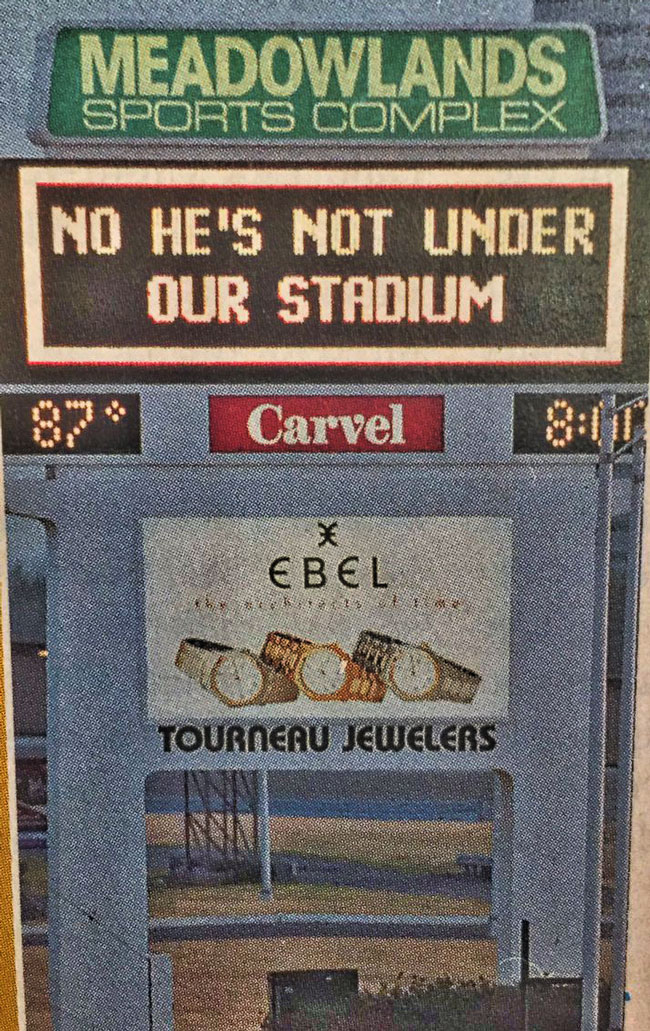
Donald Frankos, who turned state's evidence and joined the witness protection program, said Hoffa was murdered in Michigan and kept there for five months in an oil drum. Later, he was buried in the Meadowlands Sports Complex during its final stages of construction. In 1993, Meadowlands officials posted a large message on their marquee: "No, he's not under our stadium."

According to Marvin Elkind, Hoffa's one-time chauffeur and an FBI informant for more than twenty years, Hoffa's remains were buried beneath the Renaissance Center in downtown Detroit. Detroit capo Anthony Giacalone is said to have revealed this information during a Teamsters meeting in 1985.

In 2006, demolition workers in search of Hoffa's body tore down a horse barn which was supposedly built over the spot where an FBI informant claims he saw the labor leader buried in 1975,
rolled up in a rug.

Police tape blocks a driveway where authorities drilled for soil samples in the floor of a shed at a Roseville, Michigan home on September 28, 2012. Police have been told by a source that Jimmy Hoffa may be buried beneath a driveway.
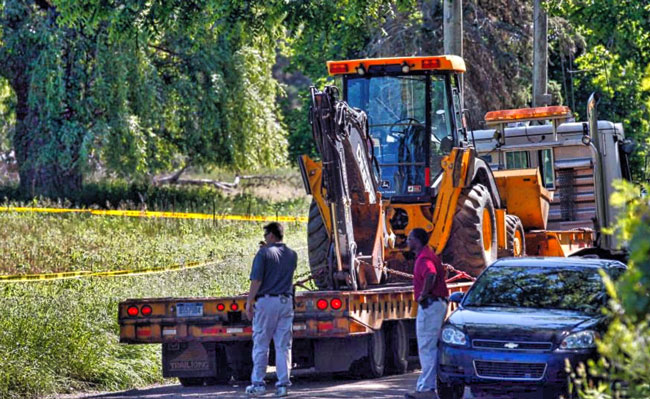
Federal investigators stand next to heavy equipment by a field which they're prepared to dig up for the remains of Jimmy Hoffa in Oakland Township, Michigan, on June 17, 2013. Their efforts were fruitless.
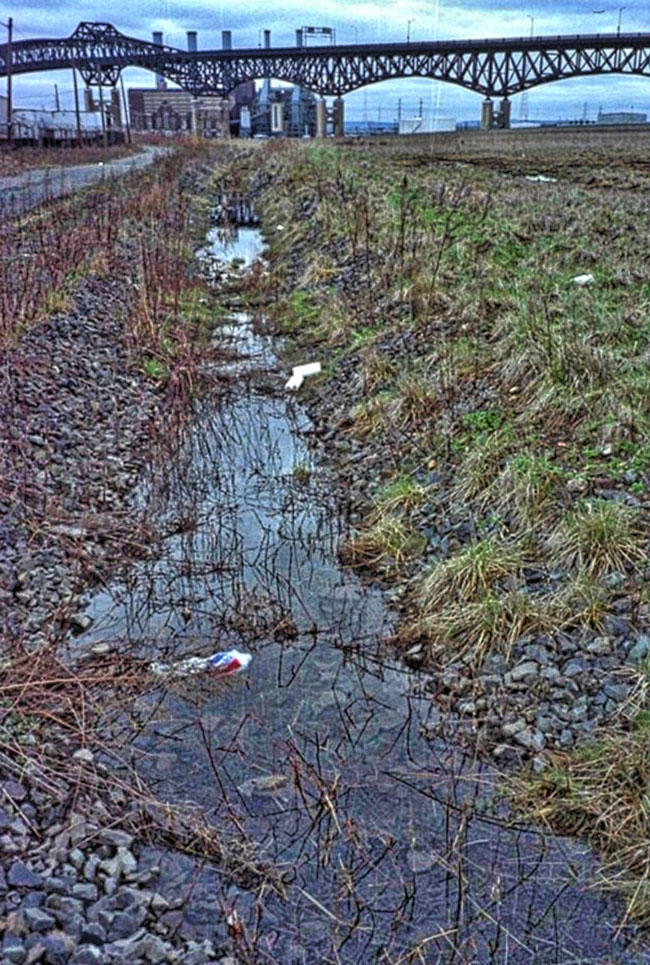
New reports suggest that Hoffa's remains can be found at one of the first sites that investigators searched after he vanished in 1975.
Late mobster Phillip (Brother) Moscato gave several recorded interviews before he died, saying that Hoffa had been entombed in a 55-gallon drum and buried at a toxic waste dump under the Pulaski Skyway in Jersey City, New Jersey, which Moscato owned at the time. Police searched the site under the Pulaskia Skyway in 1975 looking for a 50-gallon barrel they believe Hoffa may have been in, but
never found it.
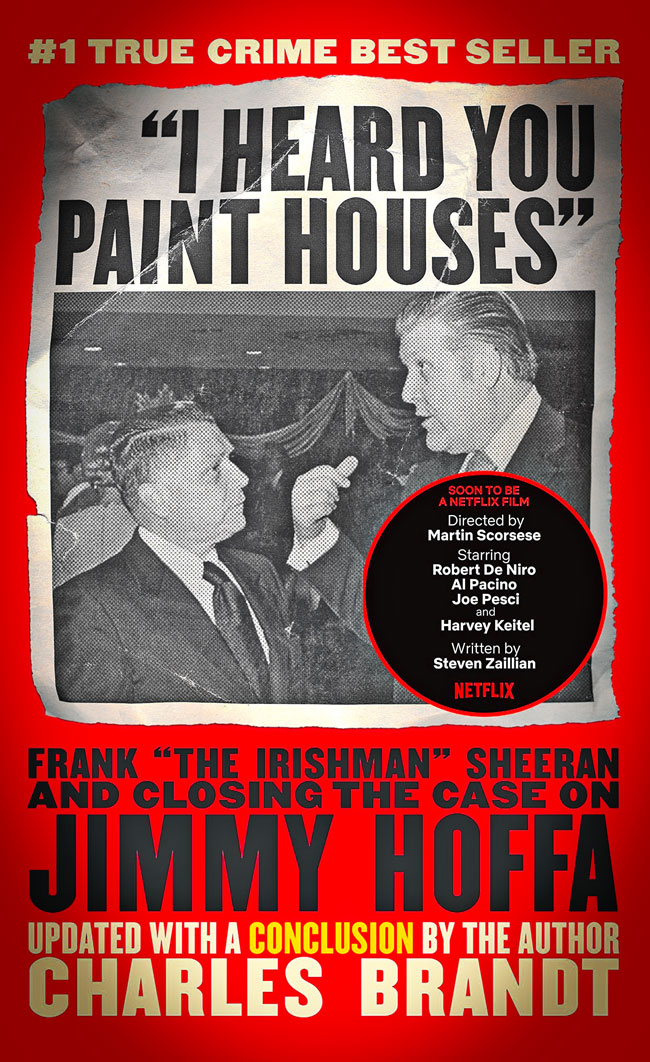
"I heard you paint houses" are the first words Jimmy Hoffa ever spoke to Frank "the Irishman" Sheeran. To paint a house is to kill a man. The paint is the blood that splatters on the walls and floors. In the course of nearly five years of recorded interviews Frank Sheeran confessed that he handled more than twenty-five hits for the mob, and for his friend Hoffa. Sheeran learned to kill in the U.S. Army, where he saw an astonishing 411 days of active combat duty in Italy during World War II. After returning home he became a hustler and hit man, working for legendary crime boss Russell Bufalino. Eventually he would rise to a position of such prominence that in a RICO suit then-U.S. Attorney Rudy Giuliani would name him as one of only two non-Italians on a list of 26 top mob figures. When Bufalino ordered Sheeran to kill Hoffa, he did the deed, knowing that if he had refused he would have been killed himself. Sheeran's important and fascinating story includes new information on other famous murders, and provides rare insight to a chapter in American history. Charles Brandt has written a page-turner that is destined to become a true crime classic.
Amazon web page
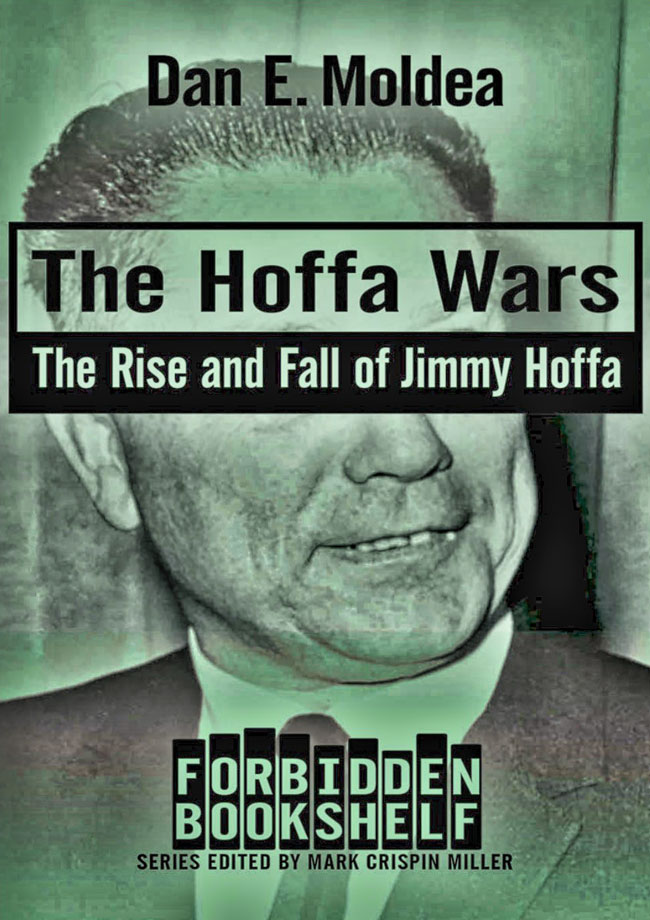
The definitive portrait of the powerful, corruption-ridden Teamsters union and its legendary president Jimmy Hoffa — organizer, gangster, convict, and conspirator — with a new afterword by the author.
James Riddle "Jimmy" Hoffa was one of the most fascinating and controversial figures in 20th-century America. His remarkable journey from young union organizer to all-powerful head of the International Brotherhood of Teamsters is an epic tale worthy of a Hollywood blockbuster, jam-packed with intrigue, subterfuge, violence, and corruption. His successes were monumental, his fall truly spectacular, and his bizarre disappearance in the summer of 1975 remains one of the great mysteries in American history.
Amazon web page

Donald "Tony The Greek" Frankos claimed Hoffa was killed by members of the Westies, a New York Irish gang, on the orders of Genovese crime family boss Anthony "Fat Tony" Salerno.
Even among the Mob, the Westies were feared. Starting with a partnership between two sadistic thugs, Jimmy Coonan and Mickey Featherstone, the gang rose out of the inferno of Hell’s Kitchen, a decaying tenderloin slice of New York City’s West Side. They became the most notorious gang in the history of organized crime, excelling in extortion, numbers running, loan sharking, and drug peddling. Their specialty was execution by dismemberment.
Amazon web page
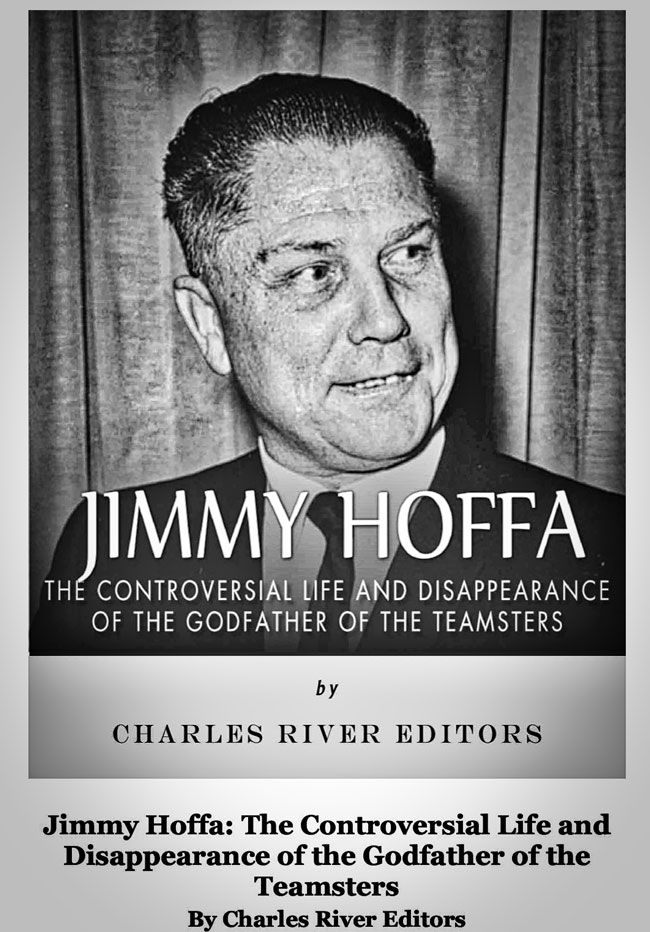
Jimmy Hoffa, once described by Bobby Kennedy as the second most powerful man in America, was a union boss who evoked both respect and fear, and he continues to be a legendary figure who often crops up in conversation and media over 40 years after his disappearance. While it was an open secret that Hoffa had shady connections, the success of his leadership allowed supporters to overlook them. As Sloane put it, “More apparent to Teamster members than any moral lapses were the tangible gains that had been steadily realized under Hoffa since his advent to power.” Charles Brandt once wrote, “From 1955 until 1965 Jimmy Hoffa was as famous as Elvis Presley. From 1965 until 1975 Jimmy Hoffa was as famous as the Beatles.” But as famous as he was in life, it was Jimmy Hoffa’s demise that continues to fascinate the country. On July 30, 1975, Hoffa drove to an important meeting at the Machus Red Fox Restaurant, but he was never seen or heard from again.
Amazon web page

"In Hoffa’s Shadow is compulsively readable, deeply affecting, and truly groundbreaking in its re-examination of the Hoffa case... a reckoning... and also a meticulous reconstruction of 'the greatest mystery in American history... a monumental achievement.'"
― James Rosen, The Wall Street Journal
"The Irishman is great art... but it is not, as we know, great history... Frank Sheeran... surely didn’t kill Hoffa... But who pulled the trigger?... For some of the real story, and for a great American tale in itself, you want to go to Jack Goldsmith’s book, In Hoffa’s Shadow.”
― Peggy Noonan, The Wall Street Journal
"It’s fair to say that the last thing the world was itching for in 2019 was another speculative account of Hoffa’s final days. Which is precisely why Jack Goldsmith’s gripping hybrid of personal memoir and forensic procedural lands with the force of a sucker punch. More than just another writer chewing over the same old facts and hypotheses, Goldsmith turns out to have a uniquely intimate connection to the case that gooses him along on his hunt for the truth."
― Chris Nashawaty, The New York Times Book Review
Amazon web page
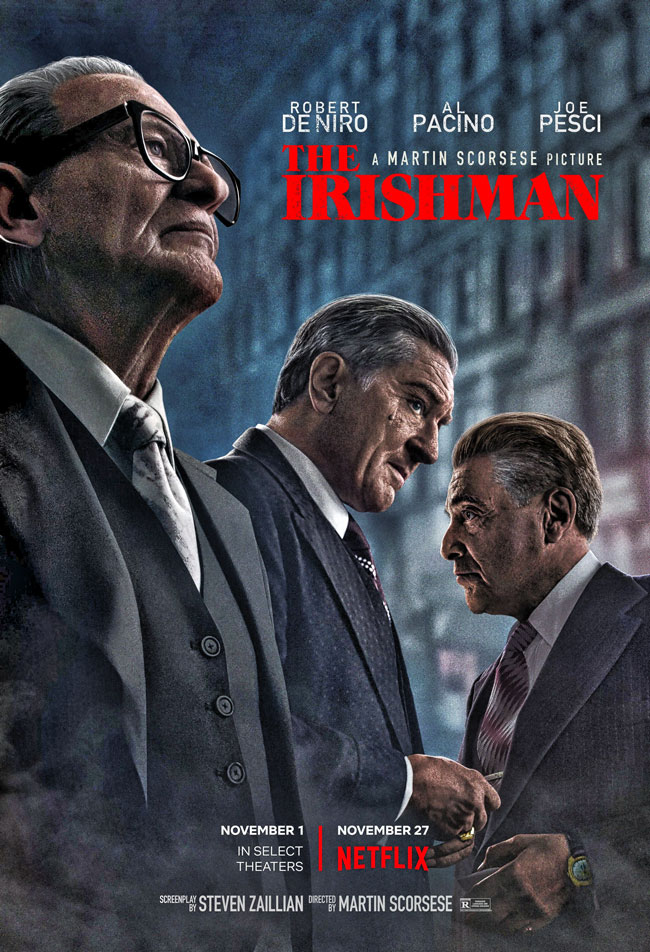
Acclaimed director Martin Scorsese's crime drama "The Irishman" is the story of Frank "The Irishman" Sheeran. The former labor union high official and hitman learned to kill in the U.S. Army, serving in Italy in the Second World War. Now he looks back on his life and the hits that defined his mob career. He claims to have played a key part in the disappearance of his life-long friend, Jimmy Hoffa.





































